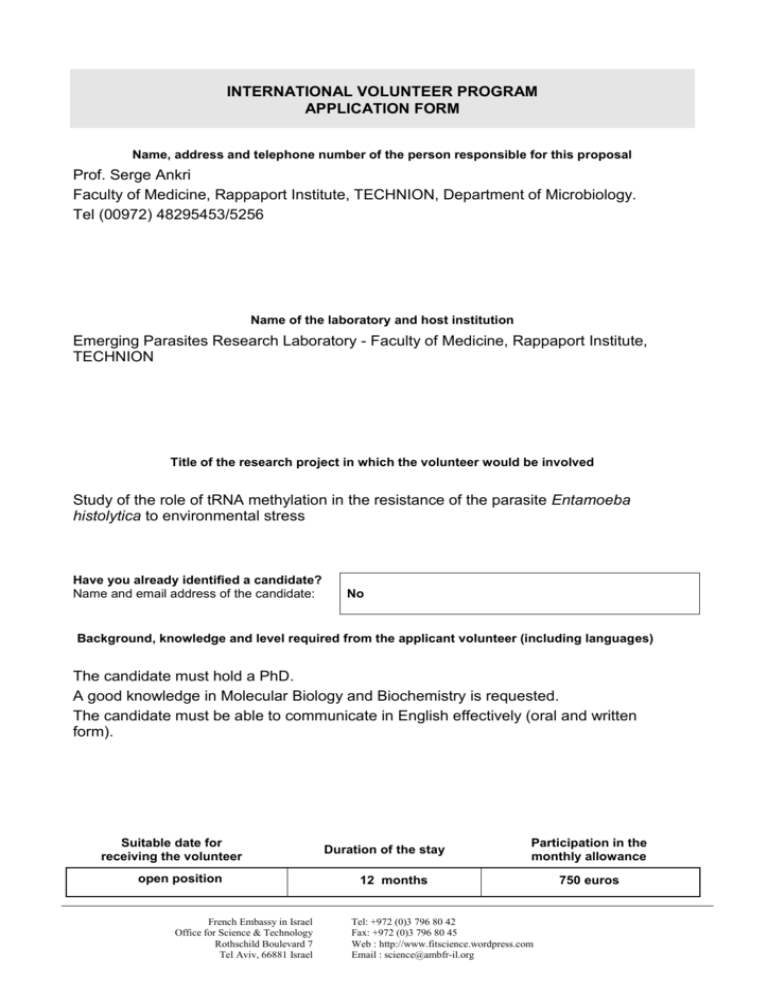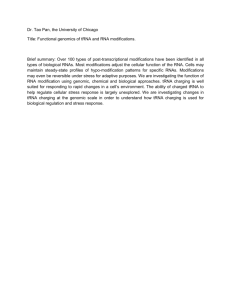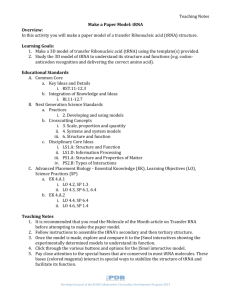Serge Ankri - WordPress.com
advertisement

INTERNATIONAL VOLUNTEER PROGRAM APPLICATION FORM Name, address and telephone number of the person responsible for this proposal Prof. Serge Ankri Faculty of Medicine, Rappaport Institute, TECHNION, Department of Microbiology. Tel (00972) 48295453/5256 Name of the laboratory and host institution Emerging Parasites Research Laboratory - Faculty of Medicine, Rappaport Institute, TECHNION Title of the research project in which the volunteer would be involved Study of the role of tRNA methylation in the resistance of the parasite Entamoeba histolytica to environmental stress Have you already identified a candidate? Name and email address of the candidate: No Background, knowledge and level required from the applicant volunteer (including languages) The candidate must hold a PhD. A good knowledge in Molecular Biology and Biochemistry is requested. The candidate must be able to communicate in English effectively (oral and written form). Suitable date for receiving the volunteer open position French Embassy in Israel Office for Science & Technology Rothschild Boulevard 7 Tel Aviv, 66881 Israel Duration of the stay Participation in the monthly allowance 12 months Tel: +972 (0)3 796 80 42 Fax: +972 (0)3 796 80 45 Web : http://www.fitscience.wordpress.com Email : science@ambfr-il.org 750 euros Description of the specific research work, which would be carried out (Please enclose a two pages description of the project – Arial 10, Line spacing 1.5 point) Background E. histolytica infection (amebiasis) concerns developing countries in Central and South America as well as Africa and Asia. This parasitic disease has a variety of clinical manifestations, from asymptomatic to colitis or liver abscess. There is no vaccine against amoebiasis but it can be treated with metronidazole, although side effects are common and resistance to this compound has been observed in other protozoa. “Epigenetics” refers to the study of changes in gene expression caused by mechanisms other than changes in the underlying DNA sequence. In recent years, epigenetics has often been associated with the regulation of particular virulence factor genes present in protozoan parasites. DNA methylation is the best characterized epigenetic modification. Its formation is catalyzed by DNA methyltransferase enzymes. In mammals, the DNA methyltransferase family (Dnmts) consists of three enzymes: Dnmt1, Dnmt3a, and Dnmt3b. A fourth enzyme, Dnmt2, belongs to a large family of proteins that are conserved in all species from Schizosaccharomyces pombe to humans. Dnmt2 is distinct from other Dnmts because (i) its length is relatively shorter than that of Dnmt1, Dnmt3a, and Dnmt3b, and (ii) Dnmt2 appears to be a tRNA methyltransferase in addition to its DNA methyltransferase activity. Our previous studies have confirmed that E.histolytica is a relevant model organism to learn about Dnmt2 functions. Ehmeth has a dual enzymatic activity In contrast to mammals, E. histolytica has a single DNA methyltransferase that belongs to the Dnmt2 protein family. The presence of methylated cytosines in E. histolytica genomic DNA was established using an antibody against 5-methyl cytosine (5mC)]. The DNA sequences that were identified by the 5mC antibodies include ribosomal DNA (rDNA), heat shock genes (HSP70 and HSP 100), and retrotransposons, thereby demonstrating that Ehmeth, the E.histolytica Dnmt2 homologue, is a genuine DNA methyltransferase. Indeed, the ability of Ehmeth to catalyse tRNAasp methylation has been recently demonstrated. This dual specificity for DNA and tRNA has also been proposed for the Dnmt2 homologue in Drosophila melanogaster. Role of Ehmeth as a tRNA MT The physiological meaning of tRNA methylation by Ehmeth is unknown. A recent work points to the role of Drosophila Dnmt2 in the regulation of tRNA degradation. In this work stress-induced cleavage of tRNAs was Dnmt2-dependent, and Dnmt2-mediated methylation protected tRNAs against ribonuclease cleavage. In S. cerevisiae, Trm9 mediated tRNA methylation is linked to the translation enhancement of genes related to stress response, DNA damage and other cellular functions. These results together with previously published data support a role of tRNA methylation in the control of tRNA stability. French Embassy in Israel Office for Science & Technology Rothschild Boulevard 7 Tel Aviv, 66881 Israel Tel: +972 (0)3 796 80 42 Fax: +972 (0)3 796 80 45 Web : http://www.fitscience.wordpress.com Email : science@ambfr-il.org Project This project will focus on two main goals: (i) to identify new Ehmeth tRNA binding targets and (ii) to better understand the physiological meaning of tRNAasp methylation in the parasite by identifying an RNAse that specifically cleaves unmethylated tRNAasp. 1- Identification of Ehmeth tRNA binding targets As opposed to aminoacyl-tRNA synthetase, examples of modification enzymes that recognize only a single out of all 40-odd tRNA species are extremely rare, and for methyltransferases such cases are not known. This raises the question of the substrate specificity of Ehmeth and the ability of Ehmeth to methylate other tRNAs in addition to tRNAasp. In order to identify such putative substrates, an RNA-CLIP assay will be used. In this technique, RNA-protein interactions are first fixed by reversible chemical cross-linking using formaldehyde or UV, and then the resultant complexes are immunoprecipitated using antibodies against the candidate protein(s). The methylation status of the newly identified Ehmeth RNA substrates will be determined by bisulfite sequencing. 2- Identification of a RNAse that specifically cleaves unmethylated tRNAasp . How exactly can tRNA methylation influence cellular phenotypes? Work from Drosophila has shown that methylation of tRNAs protects the fly from stress (heat shock or oxidative stress) induced cleavage by an RNase A-like ribonuclease angiogenin. We will determine if the same observation applies to E.histolytica. For this purpose, we will perform a Northern analysis of tRNAasp (and other tRNA Ehmeth substrates when they will be identified) using 32P-end-labeled oligonucleotides for the detection of the 5' and 3' ends of the tRNA in control trophozoites or in trophozoites exposed to heat shock, oxidative or nitrosative stresses. The identity of the RNAse from E.histolytica that cleaves unmethylated tRNA will be investigated. Several candidates exist including RMAse H and RNAse III that has been previously investigated by our group. In parallel, biochemical techniques will be used to identify the nature of this specific RNase. French Embassy in Israel Office for Science & Technology Rothschild Boulevard 7 Tel Aviv, 66881 Israel Tel: +972 (0)3 796 80 42 Fax: +972 (0)3 796 80 45 Web : http://www.fitscience.wordpress.com Email : science@ambfr-il.org




